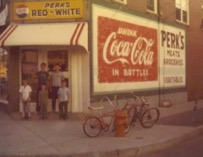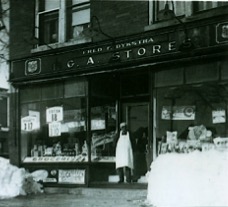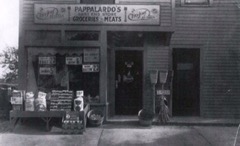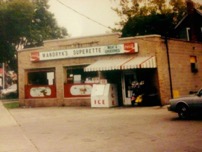Batavia had plenty of mom-and-pop stores once upon a time
Memories have a way of making you shed the years and return to the times when you were young. Life was simple and uncomplicated then. It doesn't matter what decade; many of us share a similar memory of a corner grocery store in Genesee County.
They all were a little different in size but carried the same items. It depended on where you lived, and this determined which store was considered your grocery store. At one time, there was a mom-and-pop store on almost every corner.

We would load up the wagon with pop bottles that we could return for money. If we had 20 bottles, we could earn 40 cents, and that could buy a whole bag of candy!
The excitement was when you would ask to see the box of penny candy. You could choose from many sugary treats such as Chum Gum, Pixy Sticks, Tootsie Rolls, wax lips, Bazooka bubble gum, and Safety Pop suckers, to name only a few. For a nickel, you could also buy a giant chocolate bar.
When was the birth of the mom and pop stores? One advertisement for such a store dated back to 1841. The ad stated that G. Diamond had a store that sold groceries and liquor. In 1871 Dailey's store was located at 28 and 30 Main St. In 1877, Charles G. Huggins had a store at 64 Main St. called Choice Groceries. Combs and Kerslake had a meat market and grocery store in 1889. Another store, L.C. Lorish Store, was located at 21-23 Jackson St. in 1890.
The Oriental Company at 43 Main St. sold tea, coffee and baking powder. There was a Jones Central Market at 5 Jackson St., J.S. Callahan Grocery at 26 Main St., and Kellogg Grocery on Oak and West Main streets. The Phelps Store was located at 113 Main St. The Flatiron Cash Grocery building was moved from Pearl Street to another retail location on the same street.

Caito brothers had a store at 56 Main St.; they sold fruits and vegetables. John S. Brown of 18 Main St. served customers from 1890 to 1928. Casey Brothers store at 118 Main St. was the longest-running store. They were in business for 40 years.
The city directories for 1939 show there were 25 mom-and-pop stores operating that year. In 1940 there were 23 stores open. The figures jumped dramatically in 1947 to 42 stores. In 1959 there were 22 stores, and then in 1968, there were only 19 stores. By 1975 there were 21 stores, and in 1988 there were just five. Sadly in 1995, only two stores remained.
The names of the stores often changed, but the locations stayed the same for many years. An example would be the store on Oak Street. In 1939 it was called Burch's. Later it became Reinhardt's, then the Short Stop.
Do you remember going to a store on Washington Avenue that you had to walk downstairs to the basement to reach the store? In 1947 it was owned by Regina Murphy and was called Downy's. I remember the store when it was known as Quartley's. Guastaferro and Pelletteries owned a store at 103 Jackson at different times. Johnston Food Store was located at 106 W. Main St. Later this store was called Corrigans.
On Main St., there was Ashes Grocery and Peter's delicatessen. On the corner of Bank and North streets was Lambert's Northside Grocery. That was where my friend Cathy and I, on a snow day, walked in a blizzard to buy Beatles cards in the '60s.
There were two stores on Ross Street -- 13 Ross and 132 Ross. The latter store changed hands many times from John Lowe to Howard Lentz, Samuel Caito, Hart and Hart, Red and White, Cummings, and then to Say's Grocery. You can't forget Perk's Red and White on the corner of Hutchins and Ellicott. Scaffetta's was on the corner of Maple and Evans Street.

I remember Bill's Meat Market at 208 Swan St. Like many others, I would go in there and buy my meat in the '70s. Bill would let you charge your purchases, and his bookkeeping method was unique. He would use meat-wrapping paper to record what customers bought and owed. When you paid your bill, he would cross off your name. Previous owners were Casimer Krause and Edwin Kiebala.
The store at 162 Jackson also had many owners. Sara Brown and Charles McNall were owners of this store in the '60s.
On the corner of Liberty and Ellicott streets was a store that had many owners. In 1937 Rose Maniace was the owner; it later changed hands and was called Bennett's Grocery. It later became known as Pieo Grocers. Salvadore Marchese and later the Riccobonos owned it for many years. Another fond memory I have was going in there as a young girl and watching my father buy Italian cheese for our Sunday meals. Now known as Southside Deli, it has been a landmark in this area for many years.

The one store that was a constant was Granger and Company. That was the tall building located at 17-23 Evans St. This was where most of these mom-and-pop stores bought the food items to sell. Granger's was a wholesale grocer and served small grocery stores and restaurants. It was initially a mill where flour was made and also had two roundhouses on the property.
Today, the last roundhouse is a UR Medicine Primary Care office.
As with the birth of the mom-and-pop store, we also have their deaths. One by one, these little landmarks would close their doors, taking with them the memories of family-owned establishments. Inevitably the big stores came to Batavia. Loblaws, Super Duper, Star Market, Jubilee, and Tops were the big names in grocery stores.
Today we have Tops Friendly Market, Save-a-Lot, and Aldi for grocery shopping. We still have corner stores, but larger supermarkets usually own them, not individual families.
I was inspired to write this story about the early stores because my father-in-law worked at Granger's for 47 years. He knew where every mom-and-pop store was located and all of the former owners by name. He had wonderful stories to go along with each store; I only wish I had written them all down.
This article is dedicated to Henry F. Starowitz Sr., the wholesale grocer who kept the mom-and-pop stores' shelves filled with groceries.
Please note that this article only contains the names of the stores for the years: 1939, `40, `47, `59, `61, `68, `75, `88, `95, and 2000. This is just a sampling of the mom-and-pop stores that were in Batavia. I know that all of the hamlets, villages, and towns in Genesee County have their mom-and-pop store memories, too.
This article is from my book "Back In the Day, Snapshots of Local History, The Way I See it."
Photos from the Genesee County History Department and Holland Land Office Museum.
Editor's note: Slight changes have been made to reprint this article.
